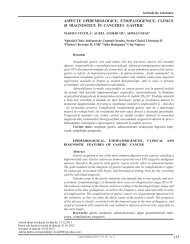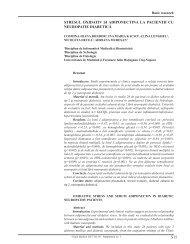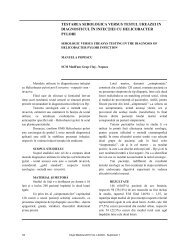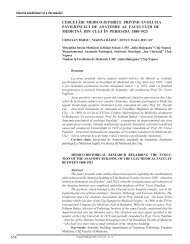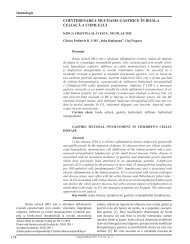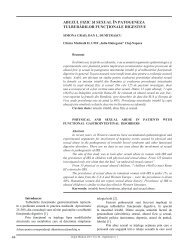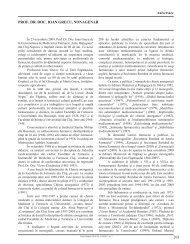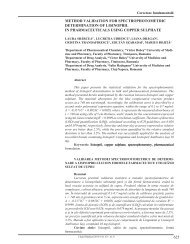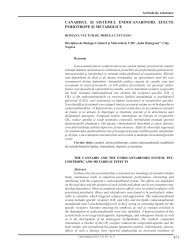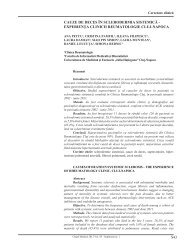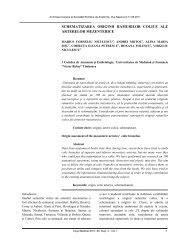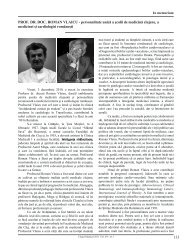Create successful ePaper yourself
Turn your PDF publications into a flip-book with our unique Google optimized e-Paper software.
<strong>Clujul</strong> <strong>Medical</strong> 2006 vol. LXXX - nr. 1<br />
disorders with signs and symptoms not sufficiently evolved to fulfill any of the accepted<br />
classification criteria for the defined connective tissue diseases. These conditions have<br />
been defined as unclassifiable connective tissue syndromes. Other terms used were<br />
latent lupus [4], incomplete lupus, and undifferentiated connective tissue diseases [5, 6,<br />
7, 8].<br />
A fundamental question raised was, whether a proportion of patients with an<br />
undifferentiated profile may see their condition remain undifferentiated or even<br />
experience a remission of all pathologic features, rather than evolving to a definite<br />
connective tissue disease (CTD). A small percentage of patients presenting with an<br />
undifferentiated profile will develop during the first year of follow up a full blown<br />
CTD. In their case, some clinical features of onset are related with the outcome. For<br />
example, the patients with arthritis and arthralgias often develop a SLE. Raynaud's<br />
syndrome is often related to systemic sclerosis. The patients with rash or face edema<br />
more likely turned out to be PM/DM patients [9,10]. Many studies conducted on<br />
undifferentiated diseases have shown that an average of 75% will maintain an<br />
undifferentiated clinical course and they will not develop a defined CTD. These patients<br />
may be defined as having a stable undifferentiated connective tissue disease (UCTD)<br />
[11]. It seems that these conditions exhibit typical clinical and serological<br />
manifestations and a good prognosis. It has been also shown that, about eighty percent<br />
of these patients have a single autoantibody specificity, more frequently anti-Ro and<br />
anti-RNP antibodies. UCTD could therefore offer an ideal clinical model for the study<br />
of single autoantibody specificities, the effects of various factors (such as pregnancy) on<br />
the disease course, and the general pathogenesis of autoimmune conditions. But before<br />
that, more must be discovered about their nature and characteristics, and studies will be<br />
necessary to improve the sensitivity and specificity of the existing preliminary<br />
classification criteria [12].<br />
In an attempt to distinguish true undifferentiated disease from an early stage of<br />
a definite CTD researchers have suggested a preliminary classification criteria set [5],<br />
according to which a patient may be defined as having a UCTD when he shows signs<br />
and symptoms suggestive of a CTD without fulfilling the criteria of any defined CTD;<br />
the patient has to be ANA positive, with a disease duration of at least 3 years.<br />
Another interesting possibility is that of a connective tissue disease which<br />
fulfills more than one classification criteria for the defined connective tissue diseases.<br />
Therefore, an autoimmune rheumatic disease can appear in conjunction with features of<br />
one or more other connective tissue diseases [13]. This is called an “overlap syndrome”<br />
or mixed syndrome. The etiologies of all autoimmune connective tissue diseases are<br />
unknown and the diagnosis depends on patterns of symptoms and signs. The problem is<br />
heightened by the tendency for one disease type to merge with another, resulting in a<br />
continuous spectrum of clinical features among the rheumatic diseases, with the<br />
traditionally accepted entities such as systemic lupus erythematosus (SLE) or systemic<br />
sclerosis occupying only part of the continuum with the overlap syndromes lying<br />
between. To identify an overlap syndrome it is necessary to identify a constellation of<br />
distinctive features which constitute a true syndrome. Mixed connective tissue disease<br />
(MCTD) is the prototype of an overlap syndrome. The relevance of defining MCTD as<br />
a separate disease entity has been challenged. Follow-up studies show that many<br />
patients originally diagnosed with MCTD develop a definite CTD, particularly<br />
scleroderma or systemic lupus erythematosus, within a few years. In patients with<br />
MCTD, primary pulmonary hypertension is an important cause of death. This condition<br />
seems to be associated with anticardiolipin antibodies. A number of case reports suggest<br />
that immunosuppressive treatment is of benefit in this almost always fatal condition.<br />
The most important aspect of MCTD as a separate entity is its association with<br />
antibodies to U1-RNP. Recent studies have suggested that the production of anti-U1-<br />
RNP is an antigen-driven process, but the nature of the trigger for its production has not<br />
been yet elucidated. Retroviral proteins do not appear to be involved. Antibodies to the<br />
140



